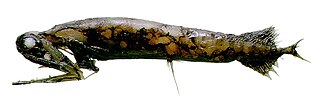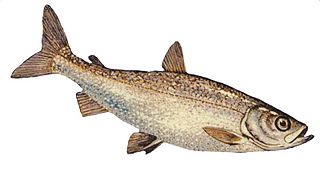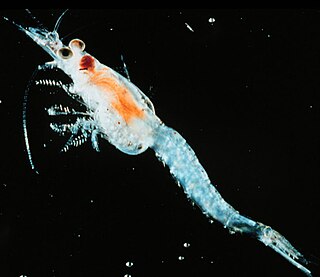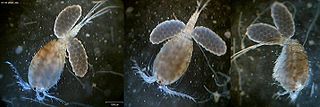
Plankton are the diverse collection of organisms found in water that are unable to propel themselves against a current. The individual organisms constituting plankton are called plankters. In the ocean, they provide a crucial source of food to many small and large aquatic organisms, such as bivalves, fish and whales.

The largemouth bass is a carnivorous freshwater gamefish in the Centrarchidae (sunfish) family, a species of black bass native to the eastern and central United States, southeastern Canada and northern Mexico, but widely introduced elsewhere. It is known by a variety of regional names, such as the widemouth bass, bigmouth bass, black bass, bucketmouth, largies, Potter's fish, Florida bass, Florida largemouth, green bass, bucketmouth bass, Green trout, gilsdorf bass, Oswego bass, LMB, and southern largemouth and northern largemouth. The largemouth bass is the state fish of Georgia and Mississippi, and the state freshwater fish of Florida and Alabama.

Zooplankton are heterotrophic plankton. Plankton are organisms drifting in oceans, seas, and bodies of fresh water. The word zooplankton is derived from the Greek zoon (ζῴον), meaning "animal", and planktos (πλαγκτός), meaning "wanderer" or "drifter". Individual zooplankton are usually microscopic, but some are larger and visible to the naked eye.

Mysida is an order of small, shrimp-like crustaceans in the malacostracan superorder Peracarida. Their common name opossum shrimps stems from the presence of a brood pouch or "marsupium" in females. The fact that the larvae are reared in this pouch and are not free-swimming characterises the order. The mysid's head bears a pair of stalked eyes and two pairs of antennae. The thorax consists of eight segments each bearing branching limbs, the whole concealed beneath a protective carapace and the abdomen has six segments and usually further small limbs.

The deepwater sculpin is a freshwater sculpin that inhabits the bottoms of cold, deep freshwater lakes of northern North America. Its distribution ranges from the Great Bear Lake of Canada to the Great Lakes. It is a designated at-risk fish species in Canada, protected as a species of Special Concern under Canada's Species at Risk Act.

Malacosteus niger is a species of fish in the family Stomiidae, the barbeled dragonfishes. It is known by the common names northern stoplight loosejaw, lightless loosejaw, black loosejaw, and black hinged-head. It lives in oceans around the world from tropical to subarctic waters where it feeds primarily on zooplankton, but is also known to consume piscivores. Its unique visual and bioluminescence permit it to see the red light produced by its photophores which most other species cannot perceive, thus making M. niger an apex predator in its ecosystem.

Coregonus hoyi, also known as the bloater, is a species or form of freshwater whitefish in the family Salmonidae. It is a silvery-coloured herring-like fish, 25.5 centimetres (10.0 in) long. It is found in most of the Great Lakes and in Lake Nipigon, and inhabits underwater slopes. This fish is not to be confused with the extinct deepwater cisco, a large fish that shared a common name with the bloater.
Trophic cascades are powerful indirect interactions that can control entire ecosystems, occurring when a trophic level in a food web is suppressed. For example, a top-down cascade will occur if predators are effective enough in predation to reduce the abundance, or alter the behavior of their prey, thereby releasing the next lower trophic level from predation.

The bloody-red mysid, Hemimysis anomala, is a shrimp-like crustacean in the Mysida order, native to the Ponto-Caspian region, which has been spreading across Europe since the 1950s. In 2006, it was discovered to have invaded the North American Great Lakes.

Mysis is a genus of mysid crustaceans in the family Mysidae, distributed mainly in the coastal zone of the Arctic and high boreal seas. Several species also inhabit northern freshwater lakes and the brackish Caspian Sea. Fifteen species are recognized. Body lengths range from 1 to 3 centimetres.

Bythotrephes longimanus, or the spiny water flea, is a planktonic crustacean less than 15 millimetres (0.6 in) long. It is native to fresh waters of Northern Europe and Asia, but has been accidentally introduced and widely distributed in the Great Lakes area of North America since the 1980s. Bythotrephes is typified by a long abdominal spine with several barbs which protect it from predators.

Neomysis integer is a species of opossum shrimp found in shallow marine bays and estuaries of Europe, with a transparent greenish or brownish body and a large cephalothorax. It is found in very shallow water in both high and low-salinity habitats. It is a filter feeder and the female broods her eggs in a brood pouch beneath her cephalothorax.

Forage fish, also called prey fish or bait fish, are small pelagic fish which are preyed on by larger predators for food. Predators include other larger fish, seabirds and marine mammals. Typical ocean forage fish feed near the base of the food chain on plankton, often by filter feeding. They include particularly fishes of the family Clupeidae, but also other small fish, including halfbeaks, silversides, smelt such as capelin and goldband fusiliers.

Macrocyclops albidus is a larvivorous copepod species.
Acartia hudsonica is a species of marine copepod belonging to the family Acartiidae. Acartia hudsonica is a coastal, cold water species that can be found along the northwest Atlantic coast.

Mysis relicta is a shrimp-like crustacean in the Mysida order, native to lakes of Northern Europe and to the brackish Baltic Sea.

Mysis diluviana is a mysid crustacean found in freshwater lakes of northern North America.

Leptodora is a genus containing two species of large, nearly transparent predatory water fleas. They grow up to 21 mm (0.83 in) long, with two large antennae used for swimming and a single compound eye. The legs are used to catch copepods that it comes into contact with by chance. Leptodora kindtii is found in temperate lakes across the Northern Hemisphere and is probably the only cladoceran ever described in a newspaper; L. richardi is only known from eastern Russia. For most of the year, Leptodora reproduces parthenogenetically, with males only appearing late in the season, to produce winter eggs which hatch the following spring. Leptodora is the only genus in its family, the Leptodoridae, and suborder, Haplopoda.

Leptodiaptomus ashlandi is a calanoid copepod zooplankton native to the Laurentian Great Lakes and their basin.

Leptodiaptomus ashlandi is a calanoid copepod zooplankton.

















